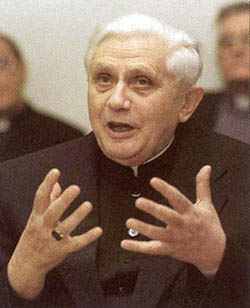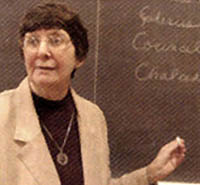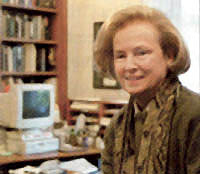 |
Feminism
Ratzinger on Feminism
Atila S. Guimarães
On July 31, 2004 the Vatican Information Service released a new document of the Congregation for the Doctrine of the Faith, signed by Cardinal Joseph Ratzinger and approved by John Paul II. The Letter to the Bishops of the Catholic Church on the Collaboration of Men and Women in the Church and in the World was predated May 31.
Real goals
Its apparent reason for being is to combat two forms of feminism that are harming contemporary culture. The real reason, in my opinion, is to reaffirm the progressivist notion of feminism already drafted in Mulieris dignitatem (1988). Its practical purpose, I would guess, is to send a message of the Conciliar Church about feminism that is palatable to the UN and can be adopted in its approaching Year of the Woman, 2005.
A Jewish erotic background
In its general lines, the document is clearly personalist, that is, a man or woman would not be able to fulfill himself or herself unless they share their own beings with one another. Only this sharing of two individuals would characterize the “person.” This is an implicit denial of the Thomistic notion of the individual as the first cell of Philosophy, and each one’s search for an Absolute to achieve moral union with God.

Cardinal Ratzinger reaffirms the progressivist interpretation of creation - I.V., June - July, 1999 |
Along with this erroneous philosophical approach, the document also presents a progressivist interpretation of creation and the Bible: Adam and Man in Genesis would not refer to an individual of the masculine sex, but to the genre “articulated in the male-female relationship” (n. 5). Only in this relationship would Man be the image and likeness of God. The male-female union includes the sexual act, which would be the physical expression of this likeness of God. It would be “right from the beginning the nuptial attribute, that is the capacity of expressing love in which the person becomes a gift” (n. 6c). The naked male and female bodies are oriented to “communion” which is the image of God (ibid.). This integration of what is masculine and what is feminine “expresses a fundamental aspect of the similarity with the Triune God” (n. 6d). It should be a “physical, psychological and ontological complementarity” (n. 8b).
Such a presentation of Adam as a genre has already been condemned by the Catholic Church, as has the “historical” interpretation (free-examination) of the first chapters of Genesis (1).
1. Regarding Adam as a genre and not as an individual, see the condemnation by Pius XII in his Encyclical Humani generis (Denzinger-Rahner n. 2328); regarding the “historical” interpretation of the first chapters of Genesis, see the condemnation by the Biblical Commission of St Pius X, June 30, 1909 (Denzinger-Schonmetzer nn. 3512-4).
Further, in this paragraph there is a real exaltation of eroticism as the image and likeness of God. Since there is no special emphasis stressing that the sexual act should take place only in matrimony, we have an implicit stimulus toward free love. Even if the sexual act were to be considered only inside matrimony, the strong emphasis given to love implicitly puts procreation in a secondary place, conflicting with Catholic doctrine which teaches procreation is the primary goal of the marriage.
According to this progressivist interpretation, the original sin would have taken place when man denied “communion,” the sharing of his essence, and turned to be an individual. That is, he would have gone “into pure self-seeking, in a relationship which ignores and kills love and replaces it with the yoke of domination of one sex over the other” (n. 7).
Another novelty, God would not have willed and approved the submission of the wife to the husband as He did when He spoke, “Your desire shall be for your husband, and he shall rule over you” (Gn 3:16). When He said those words, according to Ratzinger, He would only have been describing a situation that should be avoided. That is, God would have been inviting women to confront those consequences (n. 7b).
After declaring that “the human dimension of sexuality is inseparable from the theological dimension” (n. 8d), the document goes on to present a fundamentally erotic vision of God’s relation with the Chosen People. Such an erotic male-female relation is “much more than a simple metaphor” (n. 9d). According to Ratzinger, “this spousal language touches on the very nature of the relationship which God establishes with his people, even though that relationship is more expansive than a human spousal experience” (ibid.).
Certainly some Prophets used a symbolic language that compared God and the people to a groom and a bride, or related the unfaithfulness of Israel to a prostitution. But this was always understood by the Church as a metaphor, a parabola to express a moral situation of union or unfaithfulness. The true relation of God with man is realized through supernatural grace, which illuminates the human intelligence, strengths the will and disciplines the sensibility. This is the essence of the God-man union, there is no need for eroticism.
In this document, however, Ratzinger states that the sexual symbolism “touches on the very nature of the relationship which God establishes with his people.” What does this mean? Would it be an ontological-moral sexual relation between God and the people? It appears so. So, with this, we would be very close to the Jewish theories of the Kaballah, according to which the Jewish god would have created everything through sexual acts, and would sustain everything and everyone in the same way.
This is the “sacred eroticism” of the Conciliar Church that can be found not only in this document but also in JPII’s Mulieris dignitatem, and numerous other documents of a pontificate so prolific in publications. They are imitations of the Theology of Love and the conception of the Church as Spouse elaborated by Hans Urs von Balthasar.
At variance with the Catholic Magisterium
The document takes as a fait accompli that women work outside the home. There is no special opposition to this state of affairs; there is no courage to remind women of their mission in the home. Just a small and timid request not to discriminate against those women who still might want to stay at home:

JPII appointed Sr. Sarah Butler, above, to the ITC and laywoman Prof. Mary Ann Glendon, below, president of one of the 10 pontifical academies.

America, March 22,2004 |
“Woman who freely desire will be able to devote the totality of their time to the work of the household without being stigmatized by society or penalized financially, while those who wish also to engage in other work may be able to do so with an appropriate work-schedule” (n. 13f).
How different from the secure and majestic position of the Church of other times facing the question of women in the world. Let me quote some lines of Pius XI in his Encyclical Casti connubii on a similar topic. He taught the following regarding the economic emancipation of the woman that presupposed she would leave home:
“Neither this emancipation of the woman is real, nor is it the reasonable and worthy liberty convenient to the Christian and noble mission of the woman and wife. It is the corruption of the feminine nature and maternal dignity, as well as the perversion of all the family, since the husband lacks his wife, the children their mother, and the entire family her vigilant guard.
"On the contrary, this false liberty and unnatural equality with man is harmful for the woman herself, because at the moment that she steps down from the royal domestic throne to which she was raised by the Gospel, quickly she will fall into the ancient slavery of Paganism, becoming a mere instrument of man” (n. 76).
Comparing this text of Pius XI with the above lines of Ratzinger, supported by John Paul II, one can evaluate the wide abyss that separates the two positions. One assumes the steps of the feminist revolution as a consummate fact, and tries to present a feminism acceptable to the modern world. The other struggles to preserve the values of the Catholic family in order to protect and promote Christendom.
These are the main points of the document. Without the pretension of having made an exhaustive analysis, I conclude that in no way does this document present a “conservative” view of women, as is being considered in some meagerly intelligent Catholic circles.
Posted September 6, 2004

Related Topics of Interest
 Is God Mother? Is God Mother?
 The Vatican's Feminism The Vatican's Feminism
 The Role of Authority in the Family The Role of Authority in the Family
 Women in Sports Women in Sports
 Nothing New in the New Age Nothing New in the New Age
 Nuns Dance at an Official Conference Nuns Dance at an Official Conference
 Life and Death of Katherine Hepburn Life and Death of Katherine Hepburn
 Women in the Middle Ages Women in the Middle Ages

|
Feminism | Hot Topics | Home | Books | CDs | Search | Contact Us | Donate

© 2002-
Tradition in Action, Inc. All Rights Reserved
|
 |

|